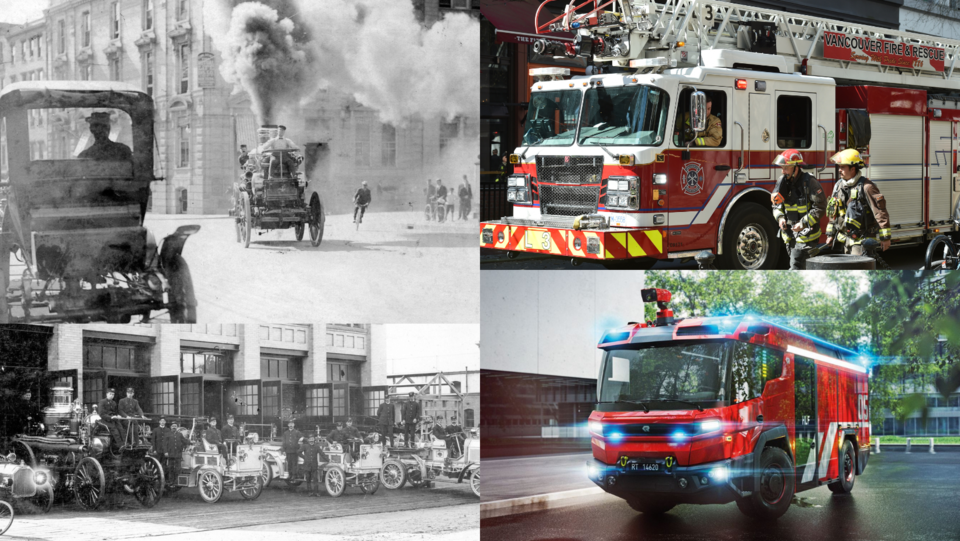Firefighting has long been an important part of Vancouver.
Just months after the city was founded the Great Â鶹´«Ã½Ó³»Fire ripped through the city, killing at least 21 people. At the time the city only had a volunteer-run fire service and a single horse-drawn buggy, but the fire encouraged the city take greater action. The first fire engine was bought by the city a week later.
Nowadays the Â鶹´«Ã½Ó³»Fire Rescue Service (VFRS) is a well-trained crew of professionals prepared to rescue people from burning buildings, deal with medical emergencies and more.
Here are five things you probably didn't know about those crews and their history.
1. It was probably first mechanized in North America
It's believed the Â鶹´«Ã½Ó³»Fire Department, as it was known at the time, was the first motorized fire department in Canada, and probably North America says VFRS spokesperson Matthew Trudeau (though he notes there aren't any formal stats from the time).
The city purchased its first (and one of the first-ever) motorized fire engines in 1908; in .
In less than a decade fire departments' as all halls were . That actually led to successful strike action by the Â鶹´«Ã½Ó³»firefighters union (the ) and firefighters were allowed one day off in four. The union went on to be one of the founding (and only Canadian) members of the International Association of Fire Fighters (IAFF).
The .
2. It'll be one of the first cities in the world with an electric fire truck
Expected later this year (entering service in 2023), Â鶹´«Ã½Ó³»is getting a Rosenbauer RT, equipment a far cry from the steam-propelled vehicles being used .
So far only a couple have been made; Berlin, Amsterdam and Dubai each have one, and Los Angeles is getting theirs going now.
Along with its electric power train, it has a variety of other features firefighters are excited for, including improved handling (it's got four-wheel steering, which means it can move diagonally), improved speed, and no diesel fumes (which is bad for firefighters health).
It also has a feature that allows it to lower itself; a common injury for firefighters is a twisted ankle while exiting a firetruck.
3. Â鶹´«Ã½Ó³»has the two busiest fire halls in Canada
While it might not be a surprise that Â鶹´«Ã½Ó³»would have the busiest fire hall in Canada, it actually has the top two. They're fire halls No. 8 (at Hamilton and Smithe) and No. 2 (at Powell and Main).
To that end, Â鶹´«Ã½Ó³»firefighters are 2 to 2.5 times busier than the average Canadian firefighter.
4. Fires have gone up 91 per cent in just a few years
While medical calls certainly a big role in keeping Â鶹´«Ã½Ó³»fire crews busy, the number of fire they're responding to are growing as much as anything.
"There are simply more fires causing damage than there was 6 years ago. We have almost 10 fires a day in Â鶹´«Ã½Ó³»that cause damage," says Trudeau in an email to Â鶹´«Ã½Ó³».
5.
Thanks to fighting between the City of Â鶹´«Ã½Ó³»and other municipalities, and despite decades of fireboats patrolling the shore, there were a few years with no Vancouver fireboats. An unusual situation for a city the size of Â鶹´«Ã½Ó³»with plenty of waterfront.
Â鶹´«Ã½Ó³»actually sold a working fireboat to San Francisco in 1989. It didn't take long for that decision to look bad.
The dispute ended when the Coast Guard base in Kitsilano had a devastating fire, and there were no nearby fireboats to tackle it. from 1991 shows the fire.
Bonus: Canada's first and maybe only library/fire hall combo
Â鶹´«Ã½Ó³»may be the only city in the country, perhaps further, with a library and fire hall combined. Firehall 4 and the Firehall branch of the Â鶹´«Ã½Ó³»Public Library share a building in Fairview on West 10 Avenue.
Both are public institutions, but as fire halls can be loud places with fast-moving vehicles and libraries tend not to be either of those things it's a combination we can't find other examples of.
with files from Alanna Kelly




